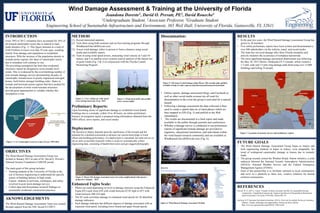
Poster for Undergraduate Research Symposium February 27th, 2014
- 1. Dissemination: • Online reports, damage-assessment blogs, and Facebook as well as other social media avenues are all used for dissemination in the event the group is activated for a natural hazard. • Following a damage assessment the data collected is then used to create a spatial data set of rated photos which are then mapped in GIS (Fig. 5) and publish to the Web immediately • The results are documented in a final report and made available to the public through journals and conferences. • Whether a damage survey is conducted or not preliminary reports of significant tornado damage are provided to engineers, educational institutions, and individuals within the wind hazard research community and are available at Windhazard.DavidOPrevatt.com (Fig. 6). Wind Damage Assessment & Training at the University of Florida Jeandona Doreste1, David O. Prevatt, PE2, David Roueche3 1Undergraduate Student, 2Associate Professor, 3Graduate Student Engineering School of Sustainable Infrastructure and Environment, 365 Weil Hall, University of Florida, Gainesville, FL 32611 OBJECTIVES The Wind Hazard Damage Assessment Group was formed in January 2012 as part of Dr. David O. Prevatt’s National Science Foundation CAREER award. The main goals of this group includes: • Training students at the University of Florida in the use of forensic engineering to understand the specific causes of building failures in high winds • Expose students to activities, techniques, and safety involved in post-storm damage surveys • Collect data and disseminate research findings on sustainable residential construction practices. METHOD (1) Recruit interested students, (2) Train them using both seminars and on-line training programs through Windhazard.DavidOPrevatt.com, (3) Assess wind damage, either in person or from a distance using social media and available reports, (4) Train in using wind speed towers, measuring wind velocity at 5 and 10- meters, and 5-m satellite tower systems used in analysis of the lateral size of gusts winds (Fig. 2 & 3) in conjunction with the Florida Coastal Monitoring Program. Preliminary Reports: Upon becoming aware of significant damage to residential wood famed buildings due to a tornado, within 24 to 48 hours, an online preliminary forensic investigation report is prepared using information obtained from the NWS offices, news reports, and social media. Deployment: The decision to deploy depends upon the significance of the tornado and the potential for a detailed assessment to advance our current knowledge of wind effects and building performance. If a deployment is warranted, the team arrives on site as early as possible (typically within a week) to systematically collect engineering data, consisting of handwritten notes and geo-tagged photographs. Enhanced Fujita Scale: • Photos are rated depending on level of damage intensity using the Enhanced Fujita (EF) scale from EF0 with winds between 65-85 mph to EF5 with winds between 200-234 mph • The EF scale correlates damage to estimated wind speeds for 28 identified damage indicators • Each damage indicator has different degrees of damage associated with an expected wind speed, including lower bound and upper bound speeds. AKNOWLEDGEMENTS The Wind Hazard Damage Assessment Team was created through support from the NSF Award #1150975. Figure 1: Operating PNE device INTRODUCTION From 1993 to 2012, tornadoes have accounted for 36% of all insured catastrophic losses due to natural or man- made disasters (Fig. 1). This figure amounts to a total of $140.9 billion in losses over that 19-year span, resulting mainly from damage and reparations to residential structures. With the increase of the population density in tornado-prone regions, the share of catastrophic losses due to tornadoes will continue to rise. The prevailing assumption has been that residential structures cannot be designed to resist tornado level winds. This is evidenced by the overwhelming number of post-tornado damage surveys documenting decades of catastrophic tornado loses to poorly engineered and aged homes, built before stronger building codes. States in tornado and hurricane-prone regions that have pushed for the development of more wind-resistant structures provide great opportunities to validate whether this assumption is true. RESULTS • In the past two years, the Wind Hazard Damage Assessment Group has grown to 20 members • Five online preliminary reports have been written and disseminated to over 500 stakeholders via the website, email, and social media. • The team has surveyed damage after three Florida tornadoes and actively monitors the occurrence of tornadoes nationwide. • The most significant damage-assessment deployment was following the May 20, 2013 Moore, Oklahoma EF-5 tornado, which created a 1.3 mile wide and 17-mile long damage path destroying over 12,000 buildings and killing 24 people. Figure 1: U.S. Catastrophe Losses by Cause of Loss, 1993-2012 REFERENCES Prevatt, D. O. (2011). Career: Tornado-resilient structural retrofits for sustainable housing communities. Unpublished manuscript, Engineering School of Sustainable Infrastructure and Environment, University of Florida, Gainesville, FL. Hartwig, R. P. Insurance Information Institute, (2013). Overview & outlook for the p/c insurance industry: Trends, challenges and opportunities. Retrieved from website: http://www.iii.org/assets/docs/pdf/SWAF-120613.pdf Figure 6: Wind Hazard Damage Assessment Website Figure 2: Crew setting up wind speed tower during hurricane Irene -2011 Figure 3: Wind speed (left) and satellite tower system (right) Figure 4: Moore OK damage assessment team surveying neighborhood with massive progressive damage - 2013 Figure 5: GIS map of rated damage along Moore, OK tornado path, publicly available at http://esridev.caps.ua.edu/mooretornado/mooretornado.html FUTURE GOALS • The Wind Hazard Damage Assessment Group hopes to inspire and train engineering students in hopes to reduce, even marginally, the trend of widespread catastrophic damage to houses due to tornadic loads. • The group recently joined the Weather Ready Nation initiative, a joint endeavor between the National Oceanic Atmospheric Administration (NOAA), National Weather Service and the Federal Emergency Management Agency (FEMA). • Goal of this partnership is to facilitate outreach to local communities and serve as a platform to share new, creative solutions for hazard resilient communities. Figure 7: Locations of tornado surveys and preliminary reports
